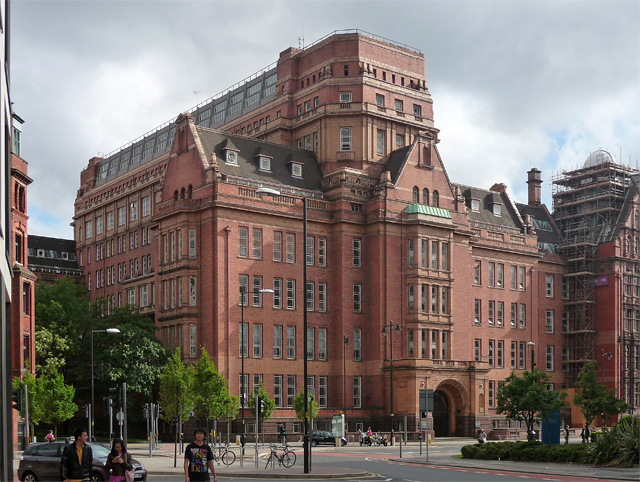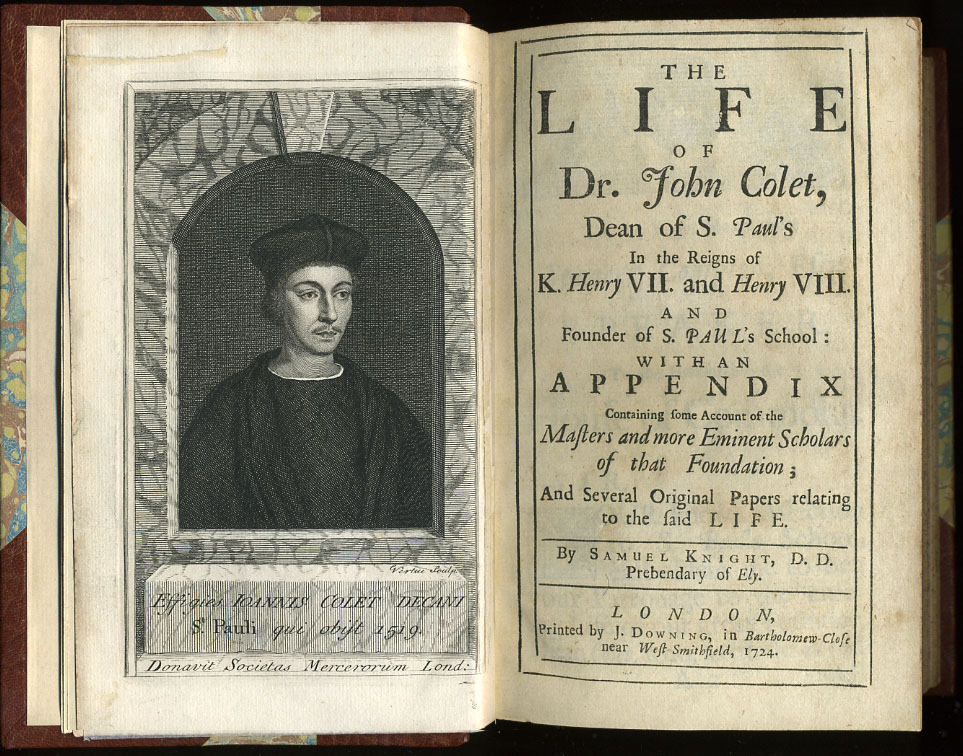|
John Edensor Littlewood
John Edensor Littlewood (9 June 1885 – 6 September 1977) was a British mathematician. He worked on topics relating to analysis, number theory, and differential equations and had lengthy collaborations with G. H. Hardy, Srinivasa Ramanujan and Mary Cartwright. Biography Littlewood was born on the 9th of June 1885 in Rochester, Kent, the eldest son of Edward Thornton Littlewood and Sylvia Maud (née Ackland). In 1892, his father accepted the headmastership of a school in Wynberg, Cape Town, in South Africa, taking his family there. Littlewood returned to Britain in 1900 to attend St Paul's School in London, studying under Francis Sowerby Macaulay, an influential algebraic geometer. In 1903, Littlewood entered the University of Cambridge, studying in Trinity College. He spent his first two years preparing for the Tripos examinations which qualify undergraduates for a bachelor's degree where he emerged in 1905 as Senior Wrangler bracketed with James Mercer (Mercer ... [...More Info...] [...Related Items...] OR: [Wikipedia] [Google] [Baidu] |
Rochester, Kent
Rochester ( ) is a town in the unitary authority of Medway, in Kent, England. It is at the lowest bridging point of the River Medway, about east-southeast of London. The town forms a conurbation with neighbouring towns Chatham, Kent, Chatham, Rainham, Kent, Rainham, Strood and Gillingham, Kent, Gillingham. Rochester was a City status in the United Kingdom, city until losing its status as one in 1998 in the United Kingdom, 1998 following the forming of Medway and failing to protect its status as a city, the first city to do so in the history of the United Kingdom. There have been ongoing campaigns to reinstate the city status for Rochester. In 2011 in the United Kingdom, 2011 it had a population of 62,982. Rochester was for many years a favourite of Charles Dickens, who owned nearby Gads Hill Place, Higham, Kent, Higham, basing many of his novels on the area. The Diocese of Rochester, the second-oldest in England, is centred on Rochester Cathedral and was responsible for foundin ... [...More Info...] [...Related Items...] OR: [Wikipedia] [Google] [Baidu] |
Copley Medal
The Copley Medal is the most prestigious award of the Royal Society of the United Kingdom, conferred "for sustained, outstanding achievements in any field of science". The award alternates between the physical sciences or mathematics and the biological sciences. It is arguably the highest United Kingdom, British and Commonwealth of Nations, Commonwealth award for scientific achievement, and has often been included among the most distinguished international scientific awards. Given annually, the medal is the oldest Royal Society medal awarded and the oldest surviving scientific award in the world, having first been given in 1731 to Stephen Gray (scientist), Stephen Gray, for "his new Electrical Experiments: – as an encouragement to him for the readiness he has always shown in obliging the Society with his discoveries and improvements in this part of Natural Knowledge". The medal is made of silver-gilt and awarded with a £25,000 prize. It is awarded to "senior scientists" irres ... [...More Info...] [...Related Items...] OR: [Wikipedia] [Google] [Baidu] |
University Of Manchester
The University of Manchester is a public university, public research university in Manchester, England. The main campus is south of Manchester city centre, Manchester City Centre on Wilmslow Road, Oxford Road. The University of Manchester is considered a red brick university, a product of the civic university movement of the late 19th century. The current University of Manchester was formed in 2004 following the merger of the University of Manchester Institute of Science and Technology (UMIST) and the Victoria University of Manchester. This followed a century of the two institutions working closely with one another. Additionally, the university owns and operates major cultural assets such as the Manchester Museum, The Whitworth art gallery, the John Rylands Library, the Tabley House, Tabley House Collection and the Jodrell Bank Observatory – a UNESCO World Heritage Site. The University of Manchester Institute of Science and Technology had its origins in the Manchester Mechan ... [...More Info...] [...Related Items...] OR: [Wikipedia] [Google] [Baidu] |
James Mercer (mathematician)
James Mercer FRS (15 January 1883 – 21 February 1932) was a mathematician, born in Bootle, close to Liverpool, England. He was educated at University of Manchester, and then University of Cambridge. He became a Fellow, saw active service at the Battle of Jutland in World War I and, after decades of ill health, died in London. He proved Mercer's theorem, which states that positive-definite kernels can be expressed as a dot product in a high-dimensional space Space is a three-dimensional continuum containing positions and directions. In classical physics, physical space is often conceived in three linear dimensions. Modern physicists usually consider it, with time, to be part of a boundless .... This theorem is the basis of the kernel trick ( applied by Aizerman), which allows linear algorithms to be easily converted into non-linear algorithms. References 1883 births 1932 deaths 19th-century British mathematicians 20th-century British mathematicians Math ... [...More Info...] [...Related Items...] OR: [Wikipedia] [Google] [Baidu] |
Senior Wrangler (University Of Cambridge)
The Senior Wrangler is the top mathematics undergraduate at the University of Cambridge in England, a position which has been described as "the greatest intellectual achievement attainable in Britain". Specifically, it is the person who achieves the highest overall mark among the Wranglers – the students at Cambridge who gain first-class degrees in mathematics. The Cambridge undergraduate mathematics course, or Mathematical Tripos, is famously difficult. Many Senior Wranglers have become world-leading figures in mathematics, physics, and other fields. They include George Airy, Jacob Bronowski, Christopher Budd, Kevin Buzzard, Arthur Cayley, Henry Cotterill, Donald Coxeter, Arthur Eddington, Ben Green, John Herschel, James Inman, J. E. Littlewood, Lee Hsien Loong, Jayant Narlikar, William Paley, Morris Pell, John Polkinghorne, Frank Ramsey, Lord Rayleigh (John Strutt), Sir George Stokes, Isaac Todhunter, Sir Gilbert Walker, and James H. Wilkinson. Senior ... [...More Info...] [...Related Items...] OR: [Wikipedia] [Google] [Baidu] |
Tripos
TRIPOS (''TRIvial Portable Operating System'') is a computer operating system. Development started in 1976 at the Computer Laboratory of Cambridge University and it was headed by Dr. Martin Richards. The first version appeared in January 1978 and it originally ran on a PDP-11. Later it was ported to the Computer Automation LSI4 and the Data General Nova. Work on a Motorola 68000 version started in 1981 at the University of Bath. MetaComCo acquired the rights to the 68000 version and continued development until TRIPOS was chosen by Commodore in March 1985 to form part of an operating system for their new Amiga computer; it was also used at Cambridge as part of the Cambridge Distributed Computing System. Students in the Computer Science department at Cambridge affectionately refer to TRIPOS as the ''Terribly Reliable, Incredibly Portable Operating System''. The name TRIPOS also refers to the Tripos system of undergraduate courses and examinations, which is unique to Cam ... [...More Info...] [...Related Items...] OR: [Wikipedia] [Google] [Baidu] |
Algebraic Geometry
Algebraic geometry is a branch of mathematics which uses abstract algebraic techniques, mainly from commutative algebra, to solve geometry, geometrical problems. Classically, it studies zero of a function, zeros of multivariate polynomials; the modern approach generalizes this in a few different aspects. The fundamental objects of study in algebraic geometry are algebraic variety, algebraic varieties, which are geometric manifestations of solution set, solutions of systems of polynomial equations. Examples of the most studied classes of algebraic varieties are line (geometry), lines, circles, parabolas, ellipses, hyperbolas, cubic curves like elliptic curves, and quartic curves like lemniscate of Bernoulli, lemniscates and Cassini ovals. These are plane algebraic curves. A point of the plane lies on an algebraic curve if its coordinates satisfy a given polynomial equation. Basic questions involve the study of points of special interest like singular point of a curve, singular p ... [...More Info...] [...Related Items...] OR: [Wikipedia] [Google] [Baidu] |
Francis Sowerby Macaulay
Francis Sowerby Macaulay FRS (11 February 1862, Witney – 9 February 1937, Cambridge) was an English mathematician who made significant contributions to algebraic geometry. He is known for his 1916 book ''The Algebraic Theory of Modular Systems'' (an old term for ideals), which greatly influenced the later course of commutative algebra. Cohen–Macaulay rings, Macaulay duality, the Macaulay resultant and the Macaulay and Macaulay2 computer algebra systems are named for Macaulay. Macaulay was educated at Kingswood School and graduated with distinction from St John's College, Cambridge. He taught the top mathematics class in St Paul's School in London from 1885 to 1911. His students included J. E. Littlewood and G. N. Watson. In 1928 Macaulay was elected Fellow of the Royal Society Fellowship of the Royal Society (FRS, ForMemRS and HonFRS) is an award granted by the Fellows of the Royal Society of London to individuals who have made a "substantial contribution t ... [...More Info...] [...Related Items...] OR: [Wikipedia] [Google] [Baidu] |
St Paul's School, London
St Paul's School is a Selective school, selective Private schools in the United Kingdom, independent day school (with limited boarding school, boarding) for boys aged 13–18, founded in 1509 by John Colet and located on a 43-acre site by River Thames, the Thames in London. St Paul's was one of nine English Public school (United Kingdom), public schools investigated by the Clarendon Commission, which subsequently became known as the Clarendon Commission, Clarendon schools. However, the school successfully argued that it was a private school and consequently was omitted from the Public Schools Act 1868, as was Merchant Taylors' School, Northwood, Merchant Taylors', the other day school within the scope of George Villiers, 4th Earl of Clarendon, Lord Clarendon's terms of reference. Since 1881, St Paul's has had its own Preparatory school (UK), preparatory school, St Paul's Juniors (formerly St Paul's Juniors, Colet Court), which since 1968 has been located on the same site. The ... [...More Info...] [...Related Items...] OR: [Wikipedia] [Google] [Baidu] |
Wynberg, Cape Town
Wynberg ( ) is a southern suburb of the City of Cape Town in Western Cape, South Africa. It is situated between Plumstead, Cape Town, Plumstead and Kenilworth, Cape Town, Kenilworth, and is a main transport hub for the Southern Suburbs, Cape Town, Southern Suburbs of Cape Town. History In the 1650s, Jan van Riebeeck's farm Boscheuvel, where he planted the Cape's first vineyards and was the first to produce History of South African wine, wine in the Cape, was located in the greater Wynberg area close to the slopes of Table Mountain. In 1683 land along the Liesbeek River was granted to Herman Weeckens by Simon van der Stel. The farm was named De Oude Wijnbergh (Old Wine Mountain). The Cape's rough seas in the winter months led to a formal winter anchorage in 1743 where ships would dock at Simons' Baai (present day Simon's Town). A wagon route linking Cape Town to Simon's Town went over the hill adjacent to De Oude Wjinbergh estate. When the British took control of the Cape set ... [...More Info...] [...Related Items...] OR: [Wikipedia] [Google] [Baidu] |
Mary Cartwright
Dame Mary Lucy Cartwright (17 December 1900 – 3 April 1998) was a British mathematician. She was one of the pioneers of what would later become known as chaos theory. Along with J. E. Littlewood, Cartwright saw many solutions to a problem which would later be seen as an example of the butterfly effect. Early life and education Mary Cartwright was born on 17 December 1900, in Aynho, Northamptonshire, where her father William Digby was vicar. Through her grandmother Jane Holbech, she descended from poet John Donne and William Mompesson, Vicar of Eyam. She had four siblings, two older and two younger: John (born 1896), Nigel (born 1898), Jane (born 1905), and William (born 1907). Her early education was at Leamington High School (1912–1915), and then at Gravely Manor School in Boscombe (1915–1916) before completion in Godolphin School in Salisbury (1916–1919). Cartwright studied mathematics at St Hugh's College, Oxford, graduating in 1923 with a first class deg ... [...More Info...] [...Related Items...] OR: [Wikipedia] [Google] [Baidu] |





